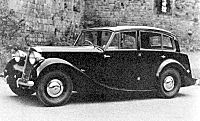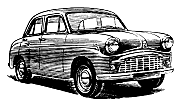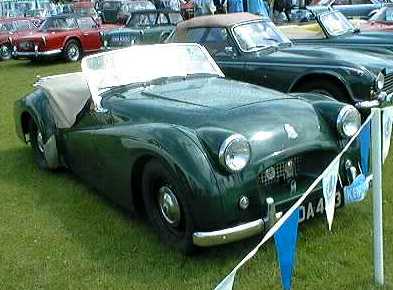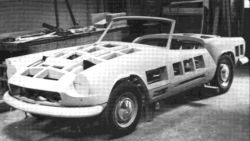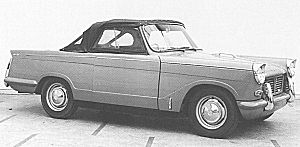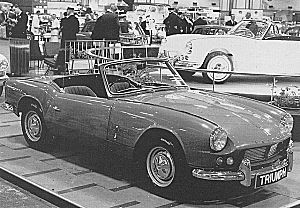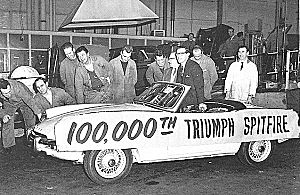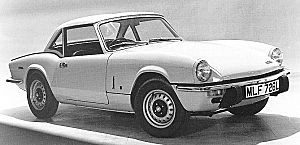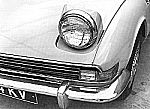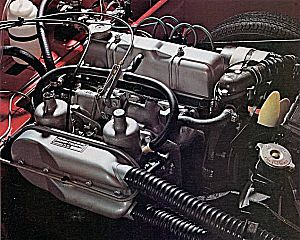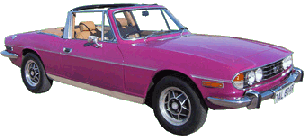|
The Triumph Motor Company had its origins in 1885 when Siegfried Bettmann and Moritz Schulte started producing Triumph bicycles at Coventry, England, United Kingdom of Great Britain and Ireland. Coventry is a city and metropolitan borough in the West Midlands of England.
Siegfried Bettman, German born of Jewish parents, arrived in the United Kingdom in 1883 where he started building bicycles, first using the Triumph name in the 1890's. He built his first motorcycle in 1902. Triumph became well established in Coventry and had German connections with a cycle factory in Nuremberg. The first three-wheeler was produced at Coventry in 1903. Some twenty years were to pass before a four-wheel Light Car was made, this was based on the Dawson, a make that had failed, and had hydraulic brakes on the rear wheels.
Triumph Renown Saloon late 1940's
The bicycle business was sold at the end of the 1920's and in 1936 the motorcycle and car businesses were separated. The multi story motorcycle factory at Priory Street, Coventry (now the site of the new cathedral) was not suitable for car production, so Bettman bought the Dawson Car Company's premises at Clay Lane and the first Triumph car appeared in April 1923. Arthur Alderson, previously at Singer and Lea-Francis, designed it.
In 1929 Triumph competed in the Monte Carlo Rally and Tourist Trophy Race in Northen Ireland. Single seaters were raced at Brooklands. In the 1930 Monte Carlo Rally Donald Healey was 7th from a field of 87 in a Super Seven thereby being the highest place British car. During the 1930's Triumph competed and won many events. Despite this Triumph were in financial difficulties by 1939 and for a time the company was owned by Thos W Ward (A well known Sheffield steel concern).
In 1921, Bettmann acquired the assets of the Dawson Car Company and started producing a 1.9 litre model called the Triumph Light Car. A number of other models were made up until the 1929 Great Depression when production almost stopped entirely. 1921 was a common year starting on Saturday (see link for calendar). ... 1929 was a common year starting on Tuesday (link will take you to calendar). The Great Depression was a massive global economic recession (or depression) that ran from 1929 to 1941.
During the 1930's, Triumph produced a number of sporting and fairly expensive cars, which were not marketed very successfully. High costs, too many models and comparatively slow sales led to bankruptcy and a takeover by a steel making group in the late 1930's.
Although initially making their own engines they turned to Coventry-Climax in 1932 but reverting again to their own in 1936/7. Triumph realised they could not compete with the likes of Austin and Morris and concentrated on the top end of the family market. In mid 1933 Colonel Holbrook took over from Siegfried Bettman as managing director. (Bettman bought the motorcycle arm in 1936 at the age of 72). The Technical Director was Donald Healey.
In the 1930s the company changed its name to the Triumph Motor Company. Donald Healey became the company’s Experimental Manager in 1934. Events and trends The 1930s were spent struggling for a solution to the global depression. Donald Mitchell Healey ( 3 July 1898 – 13 January 1988) was a noted British rally driver, automobile engineer, and speed record holder. 1934 was a common year starting on Monday (link will take you to calendar).
The Triumph bicycles and motorcycles were sold off 1936, the latter to become Triumph Motorcycles. Healey purchased an Alfa 2.3 and developed an Alfa/Triumph called the Triumph Dolomite. The Triumph Dolomite was a popular small–medium-sized four-door saloon car, made by Triumph under the British Leyland organisation.
In July 1939, the Triumph Motor Company factory, equipment and goodwill were offered for sale. T.W. Ward purchased the company and placed Healey in charge as General Manager, but the effects of the European Theatre of World War II again stopped the production of cars. During the early months of WW2, the company was geared towards war production for the British government. But in November 1940, the Coventry production facilities were almost completely destroyed by German bombing. The company went into receivership in 1939. On 31 December 1945, Sir John Black of the Standard Car Company acquired the Triumph name and the remaining assets of the company. Sir John planned to use Triumph as an upmarket 'badge' for his mass-produced Standard models. Subsequent cars were called Standard Triumph, then the Standard part of the name was dropped.
The standard 10 saloon, marketed in the US as Triumph TR10
After WW2, England was effectively bankrupt and the order of the day was 'export or die'. When Jaguar and MG turned out very successful in selling their cars in the U.S., Sir John changed his badge-engineering plan and started to develop the name Triumph as a marque on its own. The first attempt at a Triumph sports car was the TRX, a prototype based in a Standard Vanguard saloon chassis and engine. This failed to mature into a production model. The second attempt was called 'TS20' and appeared at the London Earls Court motorshow of 1952. Reactions were positive enough to develop it into a production model, the TR2, which was introduced in March 1953. The TR2 was a huge success and was followed by the largely similar TR3 and TR3A.
Triumph was making a name for itself with its sports cars across the Atlantic, so in 1957, the Standard Ten saloon was marketed in the U.S. as a Triumph TR10, clearly borrowing some of the newly won reputation of the Triumph marque.
Experiments were carried out to try to revive the former sporting image of Triumph and eventually led to the TR2 in 1953. This car was a success selling well in export markets. The TR3 became available in 1955 to be followed in January 1958 by the well-known TR3A.
TR2 (1952)
In 1958, Austin launched the Austin-Healey Sprite, a tiny little sportscar designed by Donald Healey. It was an instant success, which did not go unnoticed in the Triumph offices.
Triumph had already thought about marketing a small sportscar of its own. After the austere little Sprite had entered the market, Triumph were convinced they could do better than Austin.
Construction
of a prototype called 'Bomb' was started in September 1960 on the basis
of a 948cc Herald chassis in the Turin studio of Triumphs new Italian
designer Giovanni Michelotti. Apart from the height of the doors and its
lack of wind-down side windows, it looked remarkably like the production
model.
Full-size wooden model called a 'buck' used to shape body panels
In 1959 the Herald was announced to replace the Eight and Ten, this car had a separate chassis and boasted a 25 foot (7.6 m) turning circle. Also in 1959 three fibreglass bodied cars, the TR3S, were entered for Le Mans but none finished. Another attempt was made in 1960 with another three cars, the TRS. They all ran for the required twenty-four hours but did not qualify as they had not covered the required distance.
British Leyland
In December 1960 the company merged with Leyland Motors Ltd. December is the twelfth and last month of the year in the Gregorian Calendar and one of seven Gregorian months with the length of 31 days. 1960 was a leap year starting on Friday (link will take you to calendar). Leyland Motors was a British vehicle manufacturer of lorries and buses.
In January 1968 Leyland Motors, the company that had been the owner of Standard-Triumph since 1961, took over British Motor Holdings, which included Jaguar, Daimler and the whole of the BMC company, including Austin, Morris and MG. The merged company was rechristened British Leyland.
The 'Bomb'
The
Triumph Spitfire, unassuming as it may seem, is a car steeped in
history. It was successful in racing (Le Mans) and in rallying, and it
had a production span of 18 years, in which many model changes took
place. The
Triumph Spitfire, as the production car was to be called, would be built
on a backbone chassis-frame, based on the Herald frame, but shortened by
8.5" (216mm) and without the Herald's side members. This enabled
the designers to make the car much lower, as the seats could be placed
at the side of the chassis instead of on top, like in the Herald. The
lack of side members did call for the use strong structural sills. The
engineers had also learned from criticism about the flexibility of
Heralds on the road. This was due to the fact that Herald bodies were
largely bolted together - a feature still loved by restorers today, but
a source of early quality problems in the days of production. It was
decided to give the Spitfire a completely welded body, attached to the
frame by twelve bolts. The very useful Herald feature of a bonnet that
consisted of the complete front part of the car hinging forward was
retained on the Spitfire design.
Prototype Spitfire was tested with a shortened Herald body. A development car like this is called a 'mule'
After a purchase tax reduction, the price in 1962 for the Spitfire4 was 641 Pounds Sterling, which made it more expensive than the 587 Pounds Austin-Healey Sprite. But then the Triumph offering was much more of a sports car than the Austin. The price difference remained throughout the life of the cars - but it didn't stop the Spitfire from always outselling the Sprite/Midget range (except for one year, due to workforce strikes).
The Spitfire4 was first presented to an enthusiastic audience at the 1962 London Earls Court motor show.
Mk2
In 1964, Standard-Triumph's competitor BMC (British Motor Corporation) came up with an improved Austin Healey Sprite and MG Midget. In an answer to the marketing success of the Spitfire, it now had a proper bootlid and wind-up windows. Standard-Triumph responded with the Spitfire Mk2 in March 1965. This had a slightly more powerful engine (67 bhp instead of 63), thanks to revised manifolds and valve gear. Inside there were proper carpets instead of rubber covering on the cabin floor and the previously exposed metal on the inner door tops was now covered with trim. Hardtop, wire wheels, overdrive and even the heater were still optional. More than 37,000 Mk2's were built.
Mk3
The much-improved Mk3 went into production early in 1967. It did not go on sale in the USA until March of that year. The 100,000th Spitfire to roll off the production line on 6 February 1968 was a Mk3.
100,000th Spitfire
Due to ever-increasing mutterings of both customers and the motoring press about the build-it-yourself convertible top, the Mk3 came with a new, much improved folding soft top. This no longer needed stowing in the boot, but was more or less permanently attached to the car. Equally increasing criticism of the somewhat 'exciting' handling, due to the swing axle rear suspension, wasn't dealt with until the advent of the Mk IV. It did not prevent the Mk3 from being popular with the racing fraternity. Especially its free-revving and powerful engine made it eminently suitable for the track. Many American owners installed a 'camber compensator' to make the car less of a handful on corners. Total Mk3 production would eventually reach more than 65,000.
MkIV
In
1970, Triumph came out with what can be called an almost complete re-skin
of the Spitfire, executed by the Spitfire's original designer Michelotti.
The front was cleaned up, losing the trim strips on top of the bonnet and
the chrome headlamp surrounds. A black plastic grille and black plastic
bumper underrider covers were added.
Spitfire MkIV fresh look, restyled and a smart new hardtop
The dashboard was of the type that had already been introduced in the 1969 Mk3's for the US market: black plastic, with the main instruments in front of the driver, instead of in the middle. Later in its production life, a wood-veneered dashboard was fitted. At last, black padded sun visors, safety belts and a heater came as standard on all markets. Cars fitted with overdrive now had a sliding switch on the gearknob instead of a lever on the steering column.
Michelotti popup headlights on a prototype MkIV
The
solution of the Triumph engineers was both effective and cheap: just the
bottom leaf of the assembly remained fixed to the differential casing, but
the others were free to pivot around a central axis. This transformed the
handling of MkIV Spitfires compared to earlier models. Finally, Spitfire
drivers could throw their cars about without the danger of being launched
into the scenery.
The Spitfire 1500 engine
Spitfire 1500
Two
years before the end of MkIV production, Triumph had already introduced
the 1,493cc engine in MkIV's for the US market, albeit with a single
Zenith Stromberg carburettor. Changing the design to conform with US
emission regulations had robbed so much of the old engine's power that an
increase in swept volume was badly needed. Throughout its production life, many detail changes were made to the 1500. The main visual upgrade happened in 1976, when - in keeping with the fashion of the time - the bright stainless steel windscreen wipers, chromed door handles and door mirrors were replaced with matte black items. In 1977 the old steering column switchgear, which still stemmed from the days of the Triumph Herald, was upgraded to more modern TR7 column stalks. A few months later, the all-vinyl seats were replaced with cloth-vinyl seats.
TRIUMPH
STAG
Imagine ambling around the country roads on a perfect Spring day. You are in a classic open-top British sports car. The warm sunshine is on your face and the scent of the spring blossoms is in the air. The silky smooth 3 litre V8 burbles contentedly as you slow for the sweeping left hander and then crisply barks as you feed it a little and hasten along your merry way. Music to your ears! Share the dream and take a closer look at a Triumph Stag..........
A restored Triumph Stag in purple
A highly desirable collectable classic vehicle in original blue finish. Very sporty performance and style. Convertible to hard or soft top - for summer style and comes complete with matching hard-top which simply clips in place for snug winter motoring.
Fed up losing money on every car you buy? Why not consider this practical classic as an investment. Classic cars appreciate!
ORIGINAL TRIUMPH STAG V8 ENGINE REBUILD PAGE
JOIN THE TRIUMPH STAG OWNERS CLUB
The Stag Owners Club was formed in November 1979 and currently has about 5,500 members in 32 countries. Many events are held at both local and national level, which include concours competitions, treasure hunts, social meetings, weekend breaks and fun days. In addition there are continental trips and an annual European Meeting.
The Club arranges special insurance schemes offering competitive premium to members over 25. A valuation scheme is also available to members. An active accessories section is in operation, selling a range of goods including top-quality clothing with Club logos, books, umbrellas, models, etc. An annual National Day is our premier event held in different locations around the UK every year.
The Club has a company dedicated to the remanufacture of tooling to provide spare parts for the car - every member holds one share in this company.
Email Rachel: soc@stag.uk.net For Club joining Details contact: Peter
Robinson, The Old Rectory, Aslacton, Norfolk NR15 2JN
In the 1960s and 1970s, Triumph sold a succession of Michelotti-styled saloons and sports cars, including the advanced Dolomite Sprint, which, in 1973, already had a twin-cam, 16-valve engine. But many Triumphs of this era were unreliable, including the 2500 PI with its fuel injection problems, and the poor quality of the TR7 and TR8 sports cars, which killed the marque in the United States. This article provides extensive lists of events and significant personalities of the 1960s. This article provides extensive lists of events and significant personalities of the 1970s. Giovanni Michelotti (1921-1980) was one of the most prolific designers of sports cars in the 20th century. The Triumph Dolomite was a popular small–medium-sized four-door saloon car, made by Triumph under the British Leyland organisation. The Triumph TR7 was a sports car manufactured from 1975 to 1981 by the Triumph Motor Company, then part of British Leyland (and subsequently, BL Ltd. The Triumph TR8 was an eight-cylinder version of the wedge-shaped Triumph TR7 sports car, manufactured by BL Ltd.
The end of the Triumph story is not a happy one. In the eighties, British Leyland was troubled by bad products, bad management and a less than motivated workforce. New products like the Triumph TR7 suffered from underdevelopment and mediocre quality. Production of the TR7/8, the last true Triumph sports car, ended in 1981. The Triumph name appeared for the last time on a saloon car named Acclaim. This was little more than a rebadged Honda Ballade, which was in itself based on the Honda Civic platform of the second generation. The Triumph brand name is today owned by BMW.
The last Triumph model was the Acclaim which was launched in 1981 in a joint venture with Japanese company Honda. The Triumph name disappeared in 1984, when the Acclaim was replaced by the Rover 200, which was also simply a rebadged version of Honda's Civic/Ballade model. 1981 is a common year starting on Thursday of the Gregorian calendar. Honda Motor Co. 1984 is a leap year starting on Sunday of the Gregorian calendar. The Rover 200-series is an automobile produced by the Austin Rover Group, and latterly the Rover Group and MG Rover. The Honda Civic is an automobile manufactured by Honda.
The trademark is currently owned by BMW, acquired when it bought the Rover Group in 1994. When it sold Rover, it kept the Triumph marque. The Phoenix Consortium, which bought Rover, tried to buy the Triumph brand, but BMW refused, saying that if Phoenix insisted, it would break the deal. A trademark (Commonwealth English: trade mark)[1] is a distinctive sign of some kind which is used by a business to identify itself and its products or services to consumers, and to set the business and its products or services apart from those of other businesses. The BMW logo is a circle (known as a roundel) divided into quadrants of alternating white and light blue color. MG Rover are the largest independent manufacturer of cars in the British motor industry. 1994 was a common year starting on Saturday of the Gregorian calendar, and was designated the International year of the Family. The Phoenix Consortium is a group of four businessmen which purchased the British car company the Rover Group in April 2000, when BMW decided it was no longer willing to operate it.
Triumph-based models include
LINKS:
Triumph Model Pages
Triumph Related ModelsTriumph History
Other Clubs
Internet Discussion Groups
EventsTechnical Information
Spares and Specialists
The Website is sponsored by Solar Cola
|
|||||
|
The
content of this website is copyright © and design copyright 1991 and
2006 Electrick Publications and NJK. All rights reserved. The bird |
|||||
